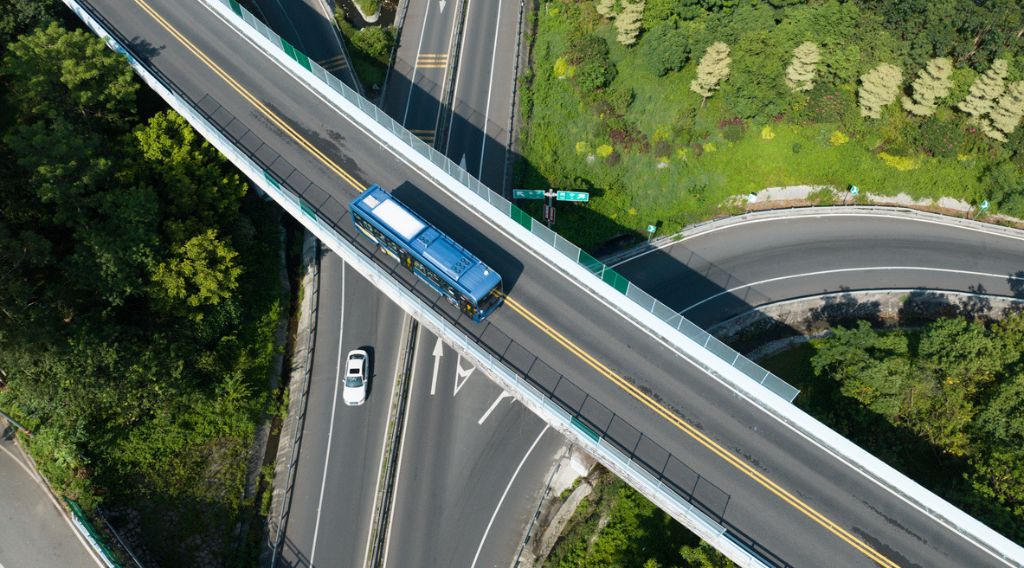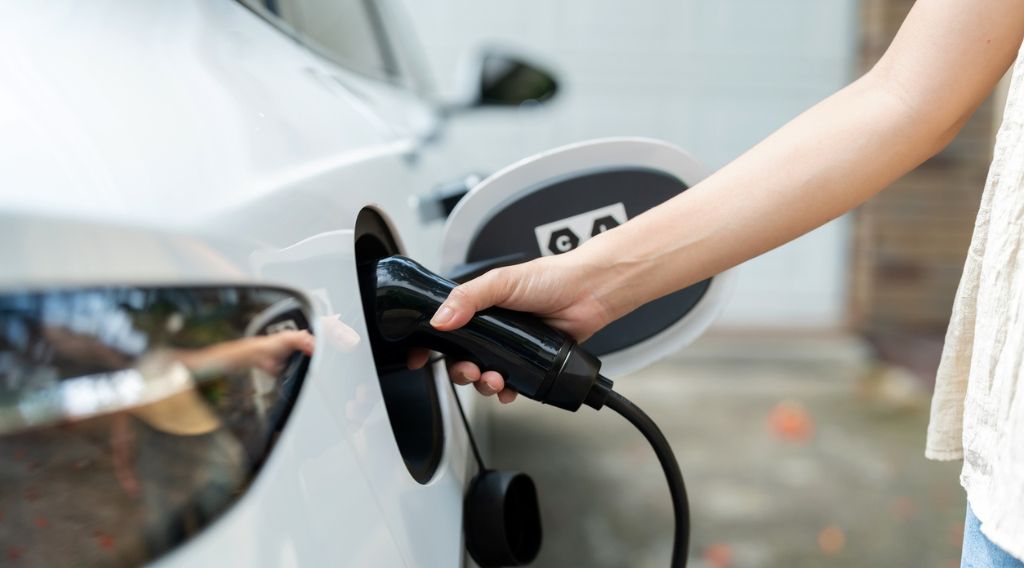
In part one of this blog series, we explored the rapid rise in electric bike (e-bike) usage and the public investments fueling this trend. E-bikes can play a key role in building a more reliable, affordable, and sustainable transportation system that reduces dependence on personal vehicles, an important part of GPI’s work to decarbonize transportation. State rebate programs and local incentives have made e-bikes more accessible than ever. But as adoption accelerates, a critical question emerges: What charging infrastructure do e-bikes require, and how do we build it to support this growth? The answer to that question is a lot more nuanced than one might think.
In this blog post, we examine charging infrastructure and storage needs for privately owned e-bikes. Part three will examine the role of bikeshare in driving e-bike usage and the unique charging infrastructure associated with those systems.
E-bike charging needs
E-bikes are generally charged much like a laptop or mobile phone, by plugging the battery directly into a standard household outlet, so in most cases, no special installation is required.
The bikes typically come in two body styles: hub-drive models, where the motor is built into the wheel hub, and mid-drive models, with the motor located near the pedals. Both styles use similar charging methods, though mid-drive bikes often have removable batteries for easier charging indoors. On a single charge, most e-bikes can travel anywhere from 20 to 70 miles, depending on battery size, terrain, and how much the rider pedals.
A common question is whether public electric vehicle (EV) charging stations can be used for e-bikes. The answer is generally no, since those stations are designed for much higher voltage and use different connectors. Instead, e-bikes are best charged using their own dedicated chargers and standard outlets.
The e-bike infrastructure gap
E-bike ownership is growing at a pace that far outstrips charging infrastructure development. For some riders, particularly those who reside in apartment buildings, charging means bringing a heavy bike or removable battery indoors, which can be inconvenient and, in some cases, unsafe, as it can increase the risk of fires and toxic fumes indoors. Similarly, secure, weather-protected storage remains scarce, particularly in dense urban areas where space is at a premium.
These gaps create barriers for riders who want to replace car trips with e-bike trips. Without reliable charging and storage, scaling e-bikes as a viable alternative to car trips is challenging. While storage is also a challenge with traditional bikes, the additional weight of e-bikes makes it more difficult to transport them into apartments, and they are usually a bigger financial investment compared to traditional bikes, making storage a more acute problem.
Public e-bike charging: What exists today
Public charging options for private e-bikes in the US are limited. Riders often rely on standard electrical outlets in workplaces, coffee shops, or garages. A few cities are experimenting with dedicated e-bike charging stations. New York City has piloted outdoor charging hubs for delivery riders to test safe, public charging for e-bikes. Portland, Oregon, is piloting secure storage and charging for e-bikes in multifamily buildings as part of its Comprehensive E-Bike Access and Support program.
Improper charging, damaged batteries, and using knock-off batteries that do not meet standards can lead to fires, making it essential that public charging infrastructure meets rigorous standards and a trained workforce operates the charging infrastructure associated with e-bikes. Portland’s pilot program will also launch a job training program, training 50 e-bike technicians and mechanics to support the repair needs of the program.
E-bike storage solutions: Safety and security
Secure, weather-protected storage is just as important as charging. Theft remains a top concern for e-bike owners, given the higher cost of these bikes than traditional bicycles. Innovative solutions are emerging:
- Smart lockers: The City of Tallinn in Estonia has installed weatherproof and safe private bicycle lockers in several public transport stops for public and free use. The lockers can be opened via key or a smartphone app, making storage secure and seamless.
- Secure bike racks: E-bike charging racks come in various shapes and sizes. Sturdy bike racks that support e-bike parking and charging are being installed in visible locations across bike rooms of multifamily buildings, downtown streetscapes, and university campuses, allowing users to charge their e-bikes where they safely park them.

- Community bike sheds: Communities are adopting shared bike sheds and charging stations as part of homeowners association guidelines to ensure safe, long-term storage for residents without garages. California passed a law in 2023 prohibiting landlords from stopping tenants from storing and recharging personal mobility devices, including e-bikes, in their units unless the landlord provides secure, long-term exterior storage.
Access is key
Low-income and high-density communities often face the greatest barriers to charging access. Residents in these areas are less likely to have access to private garages or secure outdoor spaces, making them more reliant on public charging infrastructure. Without affordable, convenient storage options, e-bikes remain out of reach for many of these households.
Policy and funding
Building public charging infrastructure for e-bikes requires collaboration between public agencies, utilities, and private partners. Several US cities are leading the way with policies that encourage bike parking and charging through innovative storage solutions.
- Portland, Oregon, requires new developments to include long-term, weather-protected bike parking and offers over 150 public bike corrals in commercial districts and secure lockers at transit stations. While the corrals don’t have access to charging, all 47 EV charging stations along Oregon’s West Coast Electric Highway have been upgraded to include 110-volt outlets that e-bike users can use for free.
- Chicago, Illinois, mandates bike parking in its building codes and has installed more than 17,000 public racks and 80 on-street corrals, complemented by monitored parking during major events. While the city does not currently mandate bike charging in its building codes, the city was the first in the country to install e-bike charging stations for shared e-bikes. We will discuss shared e-bikes in our next blog post.
- New York City is rolling out an ambitious plan to install 500 secure bike storage pods and shelters over the next five years to accommodate e-bike storage and charging.
- San Francisco, California, integrates BikeLink electronic lockers at transit hubs and offers bike valet services at events and busy shopping areas, making secure parking more convenient for riders. While the existing lockers don’t have charging capabilities integrated in them, San Francisco has made a concerted effort to include e-bike charging in all future EV charging infrastructure investments, including a project adding 300 new chargers across the city.
These examples show how local policies and investments can bridge charging infrastructure gaps and support the growing demand for e-bike-friendly facilities.
Conclusion
E-bikes are transforming how people move, but their success depends on more than just the bikes themselves. Charging and storage infrastructure is essential to ensure that e-bikes remain a practical, safe, and accessible transportation option. Sustained investments in charging infrastructure from public agencies, utilities, and private partners will be critical to sustaining the e-bike revolution.
Local governments should continue to partner with private sector companies and offer spaces in cities to provide low-cost parking and charging options to commuters. Governments and private sector investors should also prioritize including e-bike charging options as they continue to make major investments in EV charging infrastructure.
Stay tuned for the next entry in our e-bike blog series, which will explore shared e-bikes.
Reach out to GPI at info_transportat[email protected] to learn more about how your community can support and prepare for the growing shift toward electric mobility, from bikes to cars.


